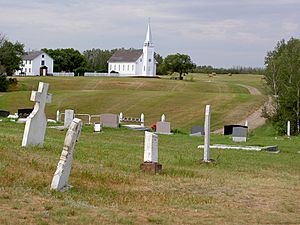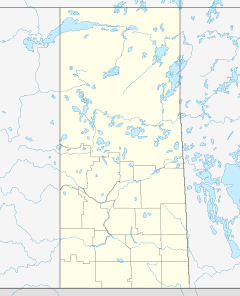Batoche, Saskatchewan facts for kids
Quick facts for kids
Batoche
|
|
|---|---|

Church, rectory and cemetery of Saint Antoine de Padoue in Batoche
|
|
| Country | Canada |
| Province | Saskatchewan |
| Region | Southcentral Saskatchewan |
| Census division | 15 |
| Rural Municipality | St. Louis No. 431 |
| Established | 1872 |
| Incorporated (village) | 1885 |
| Designation (National Historic Site) | 1923 |
| Time zone | CST |
| Postal code |
S0J 1E0
|
| Area code(s) | 306 |
| Highways | Highway 225 |
| Waterways | South Saskatchewan River |
| Official name: Batoche National Historic Site of Canada | |
| Designated: | 1923 |
Batoche, Saskatchewan is a very important historical place in Canada. It is located between Prince Albert and Saskatoon. Batoche was the site of the famous Battle of Batoche in 1885. This battle was a key event during the North-West Rebellion. In this battle, Louis Riel and his Métis forces were defeated by the Canadian government's troops.
At that time, Batoche was a small village with about 500 people. Today, very few people live there. However, the old church from 1885 and other historic buildings have been saved. Because of its history, Batoche is now a National Historic Site. This means it is a place recognized for its special importance to Canada's past.
Contents
Discovering Batoche's Past
Batoche was a settlement founded by the Métis. The Métis are a unique Indigenous group in Canada with mixed Indigenous and European (often French) heritage. The community was named after Xavier Letendre dit Batoche. It was officially started in 1872. By 1885, about 500 people lived there.
Life in the Batoche Settlement
The Métis families in Batoche lived on "river lots." These were long, narrow pieces of land that stretched from the South Saskatchewan River. This gave each family access to the river. The village had several stores and a Roman Catholic church called St. Antoine de Padoue.
Batoche became very important during the 1885 North-West Rebellion. It served as the unofficial capital for Louis Riel's Provisional Government of Saskatchewan. This government was set up by the Métis to protect their rights and lands.
Where is Batoche?
Batoche is part of what is known as the "Southbranch Settlement." It is mostly located along the east bank of the South Saskatchewan River. The area is known for its beautiful aspen parkland, which is a mix of forests and grasslands. Most people living in Batoche were Francophone (French-speaking) and Roman Catholic.
Exploring the Batoche National Historic Site
Batoche was named a National Historic Site in 1923. This means it's a special place preserved to teach people about Canadian history. When you visit, you can learn all about the community and its people.
What to See at the Site
The visitor centre at Batoche has a multimedia show. This show tells the story of the community and its history. You can also explore several restored buildings. These buildings show what life was like for the Métis people in Batoche between 1860 and 1900.
Costumed interpreters are often at the site. They act out the roles of people from the past. This helps you imagine what life was truly like back then. Some of the places you can visit include:
- A North-West Mounted Police camp, showing where the police stayed.
- A church and rectory complex, which includes the church and the priest's home.
- A traditional farm home, showing how families lived and worked.
These historic sites are spread out across the community. The Batoche National Historic Site is usually open from mid-May until mid-September.
Images for kids




